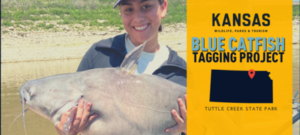 PRATT – Blue catfish are native to major river basins in eastern Kansas and can reach massive sizes; in fact, the current state record caught from the Missouri River weighed more than 100 pounds. As blue catfish populations become established in Kansas’ largest reservoirs, popularity of the species among recreational anglers also continues to grow. One waterbody that has been seeing increased attention from blue catfish anglers is Tuttle Creek Reservoir.
PRATT – Blue catfish are native to major river basins in eastern Kansas and can reach massive sizes; in fact, the current state record caught from the Missouri River weighed more than 100 pounds. As blue catfish populations become established in Kansas’ largest reservoirs, popularity of the species among recreational anglers also continues to grow. One waterbody that has been seeing increased attention from blue catfish anglers is Tuttle Creek Reservoir.
Tuttle Creek Reservoir is a 10,000-acre impoundment of the Big Blue River near Manhattan. Blue catfish likely occurred natively in small numbers in the Big Blue River but were first observed by the Kansas Department of Wildlife, Parks and Tourism (KDWPT) in Tuttle Creek in 2002. Between 2002 and 2016, approximately 162,000 blue catfish were stocked into the reservoir to help develop a naturally-sustaining population. Additionally, a more restrictive 35-inch minimum length limit and five fish daily creel were implemented in 2018 to allow fish an opportunity to spawn prior to reaching the legal length limit.
The primary long-term goal for the blue catfish fishery in Tuttle Creek Reservoir was to develop a self-sustaining population that would allow harvest opportunities for anglers. Natural reproduction was first observed in 2016 and has been documented each year since. And, a particularly large year class was produced in 2019, suggesting this population is now self-sustaining and capable of supporting increased angler harvest. As a result, KDWPT fisheries biologists will propose to change the harvest regulation in 2022 to a 10 fish daily creel that can include one blue catfish larger than 30 inches.
As with any new regulation, large amounts of data are needed to gauge effectiveness. To collect the data, KDWPT fisheries biologists will tag up to 2,100 blue catfish in Tuttle Creek Reservoir this summer. The tag will be a small yellow or orange vinyl tube affixed beneath the dorsal fin. One side of the tag will display a number unique to that fish and the other will display a phone number to report the catch. Biologists hope to gain information about population size, entrainment through the dam, and susceptibility to harvest.
The success of this project will depend largely on anglers reporting the capture of tagged fish. Biologists need the general location of where the fish was caught, length of the fish, harvest date, tag number, and whether the fish was kept or released. Anglers with this information can call (620) 342-0658 to report their catch and receive their reward. If the fish is not legal to harvest, anglers should return it to the water immediately after recording this information. If the fish is legal to harvest, anglers can either harvest or release the fish. Because part of this study is to evaluate harvest patterns, biologists encourage anglers to not let the presence of a tag influence their decision.
For questions about this project or angling in Tuttle Creek Reservoir or the Manhattan area, contact district fisheries biologist Ely Sprenkle at ely.sprenkle@ks.gov.
For information on fishing in Kansas, visit ksoutdoors.com/Fishing.




